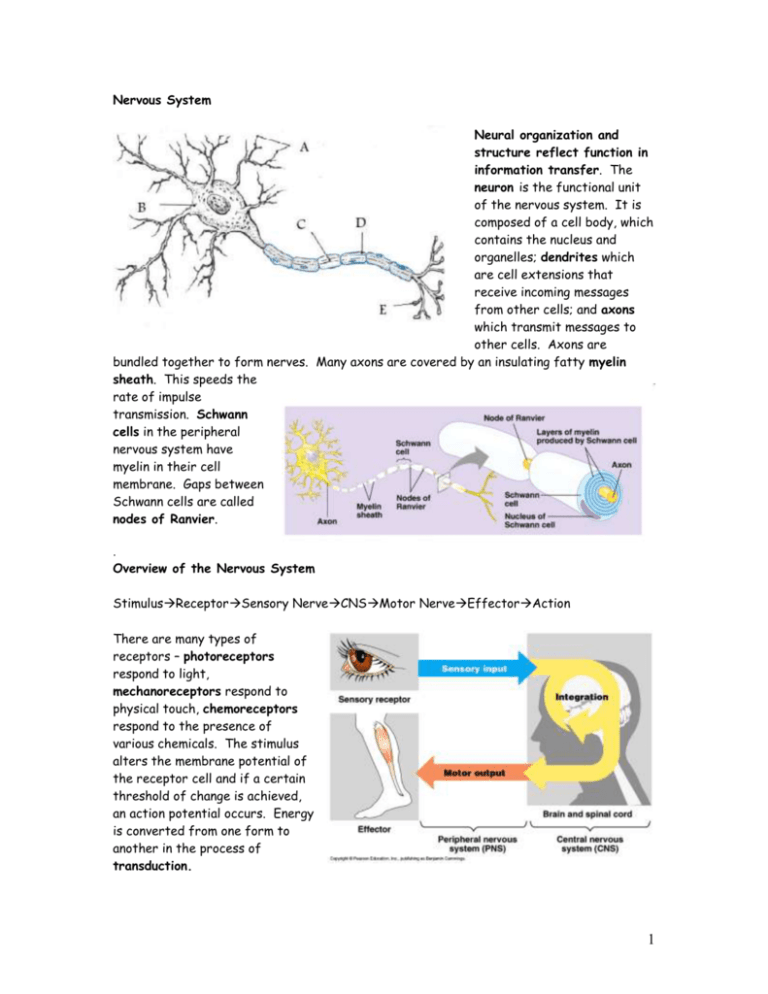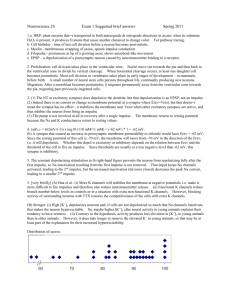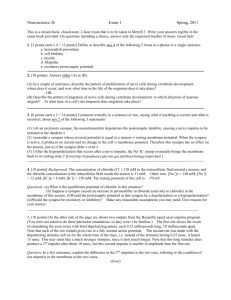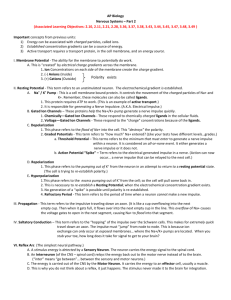Neurons, Synapses, the Nervous System
advertisement

Nervous System Neural organization and structure reflect function in information transfer. The neuron is the functional unit of the nervous system. It is composed of a cell body, which contains the nucleus and organelles; dendrites which are cell extensions that receive incoming messages from other cells; and axons which transmit messages to other cells. Axons are bundled together to form nerves. Many axons are covered by an insulating fatty myelin sheath. This speeds the rate of impulse transmission. Schwann cells in the peripheral nervous system have myelin in their cell membrane. Gaps between Schwann cells are called nodes of Ranvier. . Overview of the Nervous System StimulusReceptorSensory NerveCNSMotor NerveEffectorAction There are many types of receptors – photoreceptors respond to light, mechanoreceptors respond to physical touch, chemoreceptors respond to the presence of various chemicals. The stimulus alters the membrane potential of the receptor cell and if a certain threshold of change is achieved, an action potential occurs. Energy is converted from one form to another in the process of transduction. 1 Ion pumps and ion channels maintain the resting potential of a neuron. Membrane potential is the difference in electrical charge across a cell membrane. The membrane potential of a nerve cell at rest is called its resting potential. It exists because of the differences in the ionic composition of the extracellular and intracellular fluids across the plasma membrane. The average resting membrane potential is about -70mV. The concentration of Na+ is higher outside the cell, whereas the concentration of K+ is higher inside the cell. Changes in the membrane potential of a neuron are what give rise to nerve impulses. Action potentials are the signals conducted by axons. An action potential (nerve impulse) is an all-or-none response to depolarization of the nerve cell. A stimulus opens voltage-gated sodium channels and Na+ ions enter the cell, bringing the membrane potential to a positive value. In order to generate an action potential, a certain level of depolarization must be achieved, known as the threshold. The membrane potential is restored to its normal resting value by the inactivation of the Na+ channels and by opening voltage-gated K+ channels, which increases K+ leaving the cell. Action potentials are propagated along myelinated axons by saltatory conduction, which is the jumping of the nerve impulse between nodes of Ranvier. This speeds up the conduction of the nerve impulse. 2 Neurons communicate with other cells at synapses. The signal is conducted from the axon of a presynaptic cell to the dendrite of a postsynaptic cell via an electrical or chemical synapse. The synapse is a junction between two neurons (or a neuron and a muscle fiber or gland). Neurotransmitters are released by the presynaptic neuron into the synaptic cleft. They bind to receptors on the postsynaptic membrane and are then broken down by enzymes or taken back up into surrounding cells. There are two categories of neurotransmitters; excitatory and inhibitory. Excitatory causes depolarization of the postsynaptic membrane, whereas inhibitory causes hyperpolarization of the postsynaptic membrane. Neurotransmitters are chemical messengers released from vesicles in the synaptic terminals into the synapse. They will diffuse across the synapse and bond to receptors on the neuron, muscle fiber or gland, causing a change in the second cell. Acetylcholine is a very common neurotransmitter; it can be inhibitory (on cardiac muscle) or excitatory (on skeletal muscle). Other common neurotransmitters are epinephrine, norepinephrine, dopamine and serotonin. 3 ORGANIZATION OF THE NERVOUS SYSTEM The central nervous system consists of the brain and spinal cord; the peripheral nervous system consists of the nerves that communicate motor and sensory signals throughout the rest of the body. The peripheral nervous system consists of nerves and ganglia; it has two major branches- voluntary (somatic) and involuntary (autonomic). The voluntary division carries messages to skeletal muscles; the involuntary division carries messages to cardiac muscle, smooth muscle and glands. Cerebrum The largest part of the brain; divided into two hemispheres that are connected by a mass of white matter called the corpus callosum. The surface of the cerebrum consists mostly of gray matter (neuron cell bodies) referred to as the cerebral cortex. The cerebral cortex is folded into ridges called gyri and grooves called sulci. This allows more surface area to fit into a confined space. See the picture of the cerebrum for a summary of the functions of the cerebrum. Diencephalon Epithalamus- contains the pineal gland (an endocrine gland) that (has 3 parts secretes melatonin. This hormone probably regulates the sleep-wake cycle in humans. In other animals it has more involvement in regulating seasonal cycles. Thalamus- this part of the diencephalon has at least a dozen nuclei (clusters of neurons responsible for a certain function). The thalamus serves as a gateway for messages going to and from the cerebral cortex. Hypothalamus- also contains about a dozen nuclei. It regulates many body functions such as 1) control of the autonomic nervous system 2) emotions 3) regulation of temperature 4) sleep-wake cycles 5) hunger and thirst 6) control of the endocrine system The limbic system is a functional system containing cerebral and diencenphalon structures that mediate emotional response. 4 Midbrain Pons Medulla oblongata Cerebellum Contains centers for visual and auditory reflexes Acts as a “bridge” for messages passing to and from the cerebrum; also relays messages to the cerebellum. It also contains centers involved in respiration. This is the part of the brain that is continuous with the spinal cord. It contains a cardiac center which adjusts the force and rate of heartbeat, a vasomotor center that regulates blood pressure and the medullary respiratory center that controls the basic pattern and rate of breathing. The cerebellum receives messages from sensory organs and functions in balance and equilibrium; it helps to fine tune muscular action The sympathetic division of the autonomic nervous system is the “fight or flight” system. Its activity is evident during vigorous exercise, excitement or emergency situations. The major neurotransmitter of this system is norepinephrine. One of the target organs of the sympathetic nervous systems is the adrenal medulla, an endocrine gland which releases norepinephrine and epinephrine into the bloodstream. The parasympathetic division is most active when the body is at rest. This division is chiefly concerned with conserving energy even as it directs “housekeeping” activities such as digestion of food and elimination of waste. The neurotransmitter of the parasympathetic nervous system is acetylcholine. 5 The “all-or-none” law, as it applies to impulse transmission, states which of the following? a. If a stimulus is applied, either all neurons fire or none do. b. A stimulus causes either all the sodium to leak into the neuronal membrane or none of it. c. Either all neurons develop an action potential upon stimulation or none do. d. If a stimulus is at or above the threshold, an action potential will be generated; if not, then the neuron will not fire. If a stimulus on the receptor portion of a sensory neuron is above the threshold level, a further increase in the intensity of this stimulus will most likely cause the a. frequency of impulse production to increase b. strength of the neuronal impulse to increase c. impulse to move faster d. neuron membrane to become less permeable to sodium Which of the following would result if the sodium-potassium pump of a neuron were inoperative? A) The movement of chloride ions would produce an action potential. B) An impulse would travel from the axon to the dendrites of the neuron. C) The rate of transmission of the impulse would greatly increase. D) An action potential would not occur. Which of the following best describes the function of cholinesterase in neurotransmission? a. It decomposes, providing a source of choline for muscular contraction. b. It binds acetylcholine to receptors on the post-synaptic membrane. c. It blocks acetylcholine reception on the post-synaptic membrane. d. It breaks down acetylcholine, preventing continual neurotransmission. Lidocaine is a local anesthetic that works as a temporary pain reliever. Lidocaine binds to voltage sensitive Na+ gates on pain receptors and prevents the the gates from opening. Which of the following best describes why Lidocaine is an effective anesthetic? a. Lidocaine limits sodium influx, which increases the production of presynaptic vesicles b. Lidocaine increases sodium influx, which stimulates the propagation of the action potential c. Lidocaine decreases sodium influx, which decreases the propagation of the action potential d. Lidocaine increases sodium influx, which decreases the release of neurotransmitters Mechanoreceptors within the skin respond to physical touch. Chemoreceptors on the taste buds respond to salt, sweet, bitter and sour.Rods and cones within the retina respond to varying wavelengths of light. In each example the stimulus: a. alters membrane permeability b. uses acetylcholine as a neurotransmitter c. influences the strength of the action potential based on the source d. opens voltage sensitive gates in the axon hillock of the effector cell 6 The dendrites of olfactory receptor cells bind specific odor molecules present in the environment. The olfactory cells are located in the nasal cavity and have axons that connect to the olfactory bulb of the brain. Which of the following best describes the role of olfactory cells? a. they generate a response to the odor molecule b. they convert sensory stimuli into changes in membrane potential c. they process and discriminate among odors detected in the environment d. they integrate and interpret the sensory stimuli All of the following statements about neurotransmitters are generally true EXCEPT: a. They bind to specific receptors on the postsynaptic membrane. b. They are actively transported across the synaptic cleft. c. They are released from membrane-bound packets called vesicles. d. They may be enzymatically degraded at the postsynaptic membrane. Which of the following would occur as a result of increased activity of the sympathetic nervous system? a. Accelerated digestion b. Decreased heart rate c. Increased epinephrine (adrenalin) secretion d. Increased salivation A part of the brain used in the transfer of information from one cerebral hemisphere to the other is the a. medulla oblongata c. cerebellum b. corpus callosum d. hypothalamus 7







